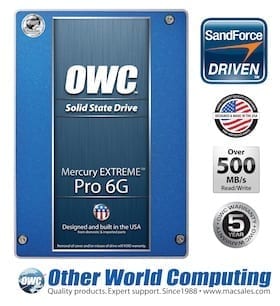 On Tuesday, Apple released the latest update to OS X with version 10.10.4, which among other improvements adds the support of TRIM for third-party SSDs.
On Tuesday, Apple released the latest update to OS X with version 10.10.4, which among other improvements adds the support of TRIM for third-party SSDs.
The new “Trimforce” command can be executed from the OS X terminal and allows users to enable TRIM on their SSDs without having to download and install anything or resort to software “hacks”.
While OWC SSDs are built to perform at optimal levels with or without TRIM enabled, you may still wonder whether you need to utilize the Trimforce tool for your SSD.
A little TRIM background
On SSDs, performance can slow down over time if the drive runs out of “empty” space where it can write data. To help with this, SSDs have a process called “garbage collection” that rearranges data and clears out unused space while the SSD is idle. TRIM helps garbage collection by telling the SSD which areas contain deleted data so that data doesn’t need to be moved.
Microsoft Windows began native support of the TRIM command for SSDs in Windows 7, and Apple added support in 10.6.8. But until 10.10.4, Apple has supported TRIM only with original Mac SSDs.
What does this news mean for your OWC SSD?
Through the DuraWrite technology, over-provisioning, and garbage collection, OWC SSDs have been built to continue running at optimal speed and provide peak performance throughout their lives without TRIM.
However, this doesn’t mean you can’t enable TRIM. Our testing has shown no issues with using Trimforce or third-party enablers with an OWC SSD*.
If you do decide to enable TRIM using an OWC SSD, to avoid any possible issues it is important to make sure that the firmware has been updated. The current generation of our SSDs need at least version 5.06 and the previous generation SSDs require version 3.65. If you aren’t running the latest version, OWC makes updating your firmware easy, and it can be found for your first or second generation OWC SSD here. As always, OWC is committed above all others to supporting the Mac platform with these continued update capabilities for Mac users.
And while you will enjoy optimal performance levels from your OWC SSD with or without TRIM active, we do applaud Apple’s decision to allow for TRIM with non-Apple SSDs. It’s an exciting development many in the SSD, Apple, and OWC community have been interested in seeing come to light.
Further reading
For more information on TRIM and your OWC SSD, please read our article at: eshop.macsales.com/blog/21641-with-an-owc-ssd-theres-no-need-for-trim
* Note: Neither Trimforce nor TRIM hacks operate under external RAIDs, or external USB/FireWire enclosures via OS X.









I’m having trouble updating the firmware of an ELECTRA SSD in my Mac Pro 2008 (3,1). After successfully creating the bootable partition with a LaCIE USB 3.0 flash drive and booting from it (latest firmware from your site), it performs the firmware update only to find that it doesn’t change the number from the old 506ABBF0 to the newest 603ABBF0. I’ve repeated it twice and still no changes in System Preferences. Old firmware remains and the updated still sees the drive as “needs update” (there is a second, much older Mercury SSD inside the Mac Pro and it says it’s up to date. Help please.
Hello Barton,
It is possible that the firmware update is only updating the older SSD. Please make sure to go into Disk Utilities and select the correct SSD.
If you are still having the same problem, please contact OWC and we will be happy to further assist you!
What about the firmware update, available as of March 30, 2015 – is that recommended for SSDs with current revision 522ABBF0? Would that bring any performance improvement or would it be the same?
I don’t plan on enabling TRIM (since performance is top notch), and if there’s no advantage on running a firmware update, I’d like to skip that as well.
If your OWC SSD Firmware revision contains xxxABBF0, then 603ABBF0 is the most up-to-date revision. It is recommended to update the firmware whenever a new one is released. This will guarantee that your SSD is running flawlessly.
Is it safe to enable TRIM on a Mercury Accelsior_E2?
Hello DT,
TRIM is not supported by the Mercury Accelsior_E2.
If you have any questions, please feel free to contact OWC!
Hi OWC,
This is a general question, but I’ll base it upon a specific example.
Product:
2 X 1TB SSD Samsung 850 Pro SATA 6.0Gb/s [purchased for high-throughput and high-capacity from OWC: http://eshop.macsales.com/item/Samsung/MZ7KE1T0BW/ ]
Application:
– Both SSD drives installed *internally* in 2012 Mac mini quad i7, by OWC turnkey service [ http://eshop.macsales.com/shop/mac-mini/install/ ].
– Then configured as 2 X RAID 0 (or RAID 1), via *either* OS X Yosemite 10.10.4 software RAID, *or* SoftRAID 5 software [purchased from OWC: http://eshop.macsales.com/item/SoftRAID/SOFTRAID5RTL/ ]. (RAID arrays backed up via Time Machine and CCC, etc.)
Question:
Will Trimforce *actually* enable TRIM to work on these *internal* RAID-configured SSDs?
Note:
Yes, the system hardware report will *indicate* that the individual drives in the RAID are TRIM-enabled.
HOWEVER, the question here is whether the SSDs, configured as part of such an *internal* RAID, *will* actually be trimmed.
In other words, is OS X able to pass the TRIM command past the RAID driver(s) to the SSDs in such an instance?
We’ve heard some tech authorities claim “Yes,” and others insist, “NO!”
The latter answer seems more likely, based on the reasoning we’ve heard.
Hoping for a definitive answer for such configurations, so we can plan, purchase, and act accordingly.
(Unfortunately, while perhaps better suited to RAID, the Mercury EXTREME Pro 6G SSD [ http://eshop.macsales.com/shop/SSD/OWC/Mercury_6G/ ] is not yet available with sufficient capacity, etc., to offer a viable alternative in our application.)
Thanks!
I was just about the ask the same question! I’m running my 2012 MBP’s OS X and apps on an 120GB OWC SSD and my files on a 750 GB HD–both internal. It’s my plan to upgrade to 2 X 1TB SSDs.
Jarrod, I’d also like to know if OWC has plans to create a SATA EXTREME pro SSD in a 960GB or 1TB.
Hello MD,
Upon testing this at OWC, we were able to find that “Trimforce “will allow individual SSDs to have TRIM enabled even when being used as an internal RAID.
This will however not work if the RAID is external. If you have any further questions please feel free to contact OWC!
I’m finally at peace with your post today regarding OWC SSDs and trim support under OS X..
In the past, you’ve recommended going without, but that statement is in such stark contrast to nearly every other tech website, and user forum readily available online regarding the subject.
I applaud your stance and statement with respect to turning TRIM on with an OWC SSD; as in theory, it should NOT harm the drive, or slow performance. This is a proud day for constantly confused and befuddled OS X users who were smart enough to purchase an OWC SSD like myself. Thank you.
Appreciate the timely article on Trimforce and Yosemite 10.10.4.
Does OWC recommend leaving Trimforce on or off for OWC Mecury drives? The article suggests that there no advantage (or disadvantage) either way. Is that correct?
Thanks.
Hi, Ty. You will get the best performance from your OWC SSD with or without TRIM active.
What about the firmware update, available as of March 30, 2015 – is that recommended for SSDs with current revision 522ABBF0? Would that bring any performance improvement or would it be the same?
I don’t plan on enabling TRIM (since performance is top notch), and if there’s no advantage on running a firmware update, I’d like to skip that as well.